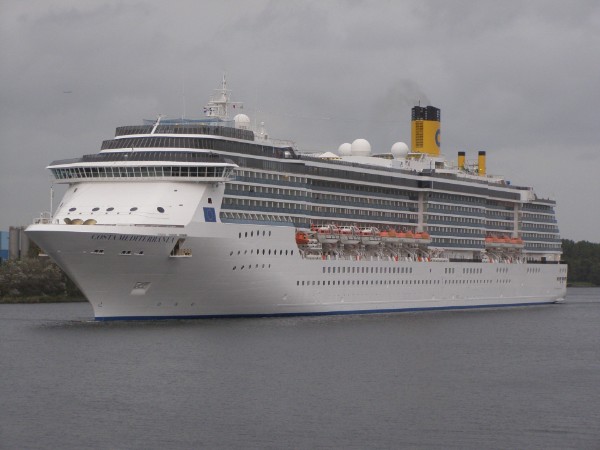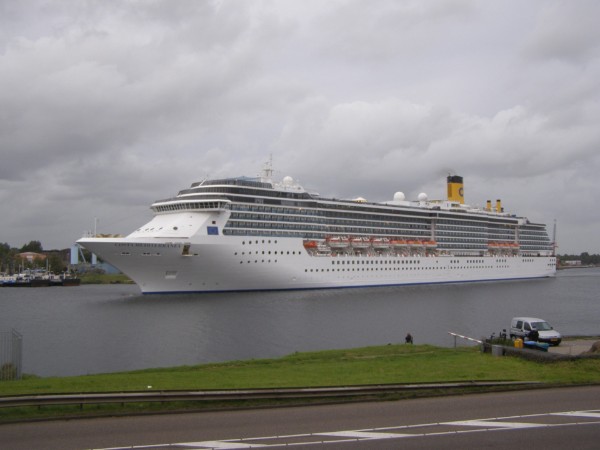Costa Mediterranea
Background

Costa Mediterranea is now a regular visitor to The Netherlands, she is seen here passing the Velsen ferrycrossing of the Northsea Canal at the 7th of september 2017.
Although Carnival Corporation was the first company to build a ship of over 100.000 tons, the Carnival Destiny (now Carnival Sunshine) that has been introduced in 1996), the next class of ships they designed was quite a bit smaller. The class, called the Project 8000 in the early stages, was especially designed to be able to sail through the locks within the Panama Canal, making them the ultimate Panamax-cruiseships in the world. In doing so, Carnival would also be able to sail cruises here with new ships, while the expectation was that larger ships would be the future. The older, smaller ships of the Jubilee and Fantasy classes were severely outdated so the company had to add ships of medium size that were more modern in style and that had the right amount of balcony cabins.
Construction and general statistics
The largest ships that were able to sail through the Panama Canal (that is before the 2016-completed widening) could be 294,1 meters in lenght, 32,3 meters in width and their depth could be 12,0 meters. The Spirit-class ships were 292,56 meters long, 32,20 meters wide and they had a draft of 7,80 meters. So it was a very tight squeeze. The tonnage measurement of Costa Mediterranea is 85.619 and she has space for a maximum count of 2680 passengers, also stated is the number of 2114 but this is based on a two-per-cabin basis. These passengers are served by 912 crewmembers at 16 decks, of which 12 are accessible for the passengers. The ship can sail at a speed of 24 knots, although her servicespeed normally will be 22 knots and she is driven by two Azipod VO systems. Their power comes from six 9-cylinder diesel-electric engines designed by Wärtsilä, delivering 62.370 kW. Six generators and two electric motors provide electricity aboard. The ship sails under the Italian flag and is homeported in the traditional Costa port of Genoa.
The ship was built at the Kvaerner-Masa Yards in Helsinki as yardnumber 502 and her keel was laid at the 1st of october of the year 2000. She floated out of her building dock at the 19th of september of 2002 and finally delivered to Costa Cruises at the 22nd of may in 2003 after a series of succesfull trials throughout april.
Sisterships
Sometimes it seems to be a pity that because of todays economics the choice for the big companies is to built many ships of the same design sometimes also spread over several of their owned companies. On the other hand, when a shipdesign is really popular with passengers it is also understandable. It just is very important for the designers to come up with interiour designs that really reflect the differences between the ships to give them their own personality. Although sisterships had been built before, the familytree of the Spirit-class can be named one of the largest. This is mainly the case because of these ships being so popular by passengers due to the excellent passengerflow, their now medium-called size and their reliability. The first ship was the Costa Atlantica, built for Costa Cruises in 2000. Costa Mediterranea was introduced in 2003 and for Carnival itself, Carnival Spirit and Carnival Pride came in 2001, Carnival Legend came in 2002 and Carnival Miracle followed in 2004. The same blueprints were used for the Vista-class of Holland America Line in the Zuiderdam (2002), Oosterdam (2003), Westerdam (2004) and Noordam (2005). For P&O Cruises a slightly altered design became their Arcadia in 2005 and for Cunard Line Queen Victoria and Queen Elizabeth were introduced in 2007 and 2010 respectively.

Design
Carnival had experimented with pod propulsion on two of the Fantasy-class ships, the Carnival Elation and Carnival Paradise, but on their newer Destiny-class, the company chose again for controllable pitch propellers. On the Spirit-class, the pods were re-introduced so they asre driven by Azipods that are powered by a newly designed diesel-engine, able to significantly reduce noxious emissions. Because of this, Spirit-class ships are perfect for not only sailing the Panama Canal, but also in pristine regions like Alaska, where environmentalfriendly ships are the standard. Around the same time, Carnival also introduced the Vista-class of ships for Holland America Line for the same reasons with a so-called CODAG system that is a combination between diesel and gas.
Some 80% of the 1057 passengercabins are outside cabins and some 70% of them do have a balcony. This number is considerably higher then other Panamax-size cruiseships and this was achieved to add one extra deck of those kind of cabins to a more narrow superstructure.
The ships central hub is of course the atrium, named Marchera d'Argento Hall, which spreads out over 10 decks and that connects many of the ships public spaces. The largest of those is the theater, Tejatro Osiris, that seats 1170 passengers. The Ristorante Degli Argentieri is the largest restaurant aboard, seating 1300 passengers and spanning two decks in height. The restaurant has a galley underneath, that is connected to the restaurant through escalators used by the waiters. Above the atrium, topped by a large glass dome is the speciality restaurant Club Medusa that can be used as one of the alternatives to the main restaurant. Of course there are also more informal diningoptions like the large Lido Restaurant Perla del Lago and the Posillipo Pizzeria.
The Ischia Spa is the ships health and fitness center, two decks in height. There also are four swimmingpools of which one can be covered by a sliding roof, five whirlpools, a shoppingarea, a weddingchapel, a large casino and extended children's fascilities.
Like all Costa ships, the Costa Mediterranea has a central theme, being the Italian palaces of the 17th ond 18th century. There are many influences from Venetian architecture built in by Carnival's and Costa's house-designer Joseph Farcus. The ships motto is 'Mai Visto niente di simile', meaning 'You've never seen anything like it'.
Carreer

After the handover ceremony at Helsinki at the 22nd of may 2003, the ship left the Finnish capital one day later and presented herself in several European cities for travelagents mostly. Her namingceremony took place in Naples at the 7th of june and her Godmother was the Spanish model Ines Sastre. Two inaugural cruises followed, before she restationed to Genoa from where her 'true' first Mediterranean season started at the 24th of july. Her itinerary also called at Naples, Palermo, Tunis, Palma de Mallorca and Barcelona. After her first season in de Mediterranean, the Costa Mediterranea crossed the Atlantic for her first Caribbean season.

